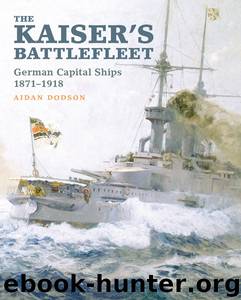The Kaiser's Battlefleet by Aidan Dodson

Author:Aidan Dodson
Language: eng
Format: epub
Tags: HISTORY / Military / General
ISBN: 9781473881556
Publisher: Seaforth Publishing
Published: 2016-11-29T16:00:00+00:00
Blücher capsizing at the battle of Dogger Bank. (Author’s collection)
After Dogger Bank
Dogger Bank was regarded, with the Hartlepool, Scarborough and Whitby operation and the destruction of three small cruisers by British battlecruisers at the First Battle of Heligoland Bight on 28 August 1914, as illustrating of the failure of von Ingenohl’s strategy. He was therefore replaced on 2 February by Hugo von Pohl (1855–1916), formerly Chief of the Naval Staff.
A number of short sorties were carried out, on 29/30 March and 29/30 May to the north of Terschelling, on 17/18 April and 17/18 May to cover II. SG mining operations, on 21/22 April towards the Dogger Bank, on 10 May to cover the return of the auxiliary minelayer Meteor (which had, however, been sunk the previous day), on 11/12 September to cover a minelaying operation west of Terschelling, and on 23/24 October as far as the Horns Reef. In no case was there any potential contact with British forces. The III. SG was withdrawn from High Seas Fleet 12 April 1915, the ships providing reinforcement for operations in the Baltic.
THE BALTIC 1914–1915
On 28 August 1914, the IV. Sqn made a foray into the Baltic after the stranding of the small cruiser Magdeburg off the Estonian coast, followed by an offensive sweep during 3–9 September, led by Blücher, detached from the I. SG (as flag), with the small cruisers Augsburg, Gazelle, Amazone and Straßburg. This succeeded in sinking a Russian merchantman and destroying some shore stations, with the flagship briefly exchanging fire with the Russian armoured cruisers Bayan and Pallada at the entrance to the Gulf of Finland on the 4th. Blücher and Straßburg returned to the North Sea on the force’s return to Kiel, while the IV. Sqn was also detached from the Baltic command, but remained at Kiel.
Otherwise, the navy undertook bombardment operations in support of the army advance, the small cruiser Augsburg bombarding Libau on the Latvian coast as early as 2 August. A bombardment for 17 November, however, was accompanied by disaster, when Friedrich Carl struck a mine in a field laid by Russian destroyers west-south-west of Memel on the 5th. Assuming that she had been torpedoed, the ship set a course for shallow water that took her back into the minefield, where she struck a further mine, causing extensive flooding aft and disabling an engine. The rudder jammed soon afterwards, Friedrich Carl’s crew being taken off by Augsburg some six hours after the first mine had been struck, and shortly before the big ship capsized and sank, albeit with only seven fatalities. Friedrich Carl was replaced as Baltic flagship by her sister Prinz Adalbert, withdrawn from the III. SG in the North Sea.
The mine danger was emphasised when Augsburg and Gazelle were damaged in two separate minefields near the Danish island of Bornholm on the night of the 24/25 January 1915. A further submarine threat had arisen in October 1914, with the first deployment of British submarines to the Baltic; as noted below, mines and torpedoes would ultimately make much of the eastern Baltic untenable for German surface vessels.
Download
This site does not store any files on its server. We only index and link to content provided by other sites. Please contact the content providers to delete copyright contents if any and email us, we'll remove relevant links or contents immediately.
| Africa | Americas |
| Arctic & Antarctica | Asia |
| Australia & Oceania | Europe |
| Middle East | Russia |
| United States | World |
| Ancient Civilizations | Military |
| Historical Study & Educational Resources |
1805 by Richard Woodman(851)
Labyrinth of Ice by Buddy Levy(648)
RMS Titanic by Peter Davies-Garner(610)
A Game of Birds and Wolves by Simon Parkin(521)
1812: The Navy's War by George C. Daughan(514)
Life by Tim Flannery(509)
Rogue Warrior by Richard Marcinko(507)
Naval Warfare, 1815-1914 (Warfare and History) by Lawrence Sondhaus(441)
Sontag, Sherry - Blind Man's Bluff by Sontag Sherry(439)
The Rise And Fall of British Naval Mastery by Paul Kennedy(433)
American Naval History by Craig L. Symonds(417)
Tracing Your Merchant Navy Ancestors by Simon Wills(417)
Warship 2019 by John Jordan(413)
The Supercarriers: The Forrestal and Kitty Hawk Classes by Andrew Faltum(395)
Roosevelt's Navy by James Tertius De Kay(374)
The Imperial Cruise by James Bradley(367)
The Imperial Cruise: A Secret History of Empire and War by James Bradley(364)
Men-of-War by Patrick O'Brian(362)
Modern Military Strategy by Elinor C Sloan(350)
